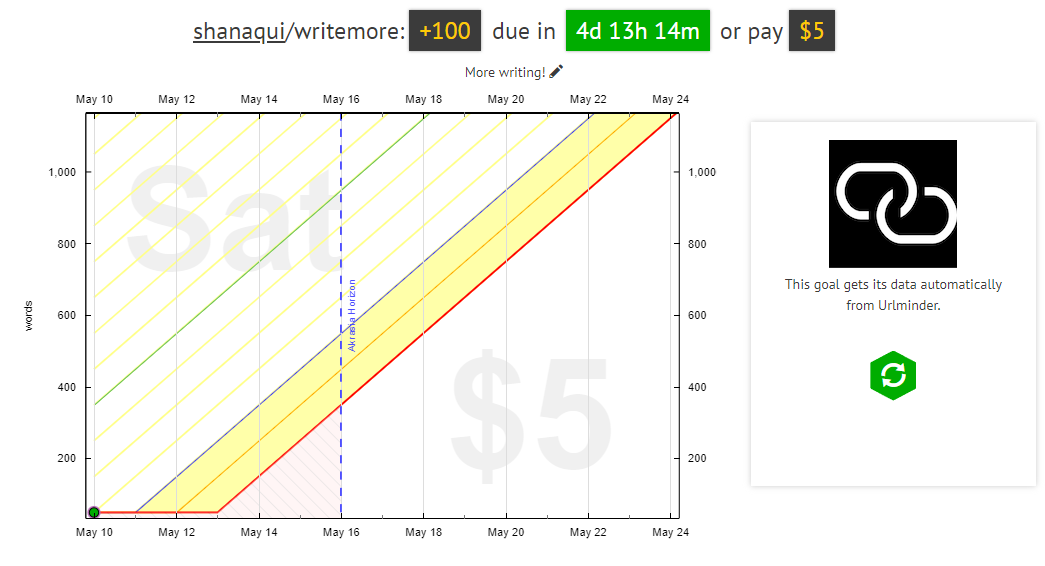URLminder
- What can I beemind with URLminder?
- Can I beemind private documents with URLminder?
- How do I get a sharable link from Google Docs or Dropbox?
- The datapoint from URLminder is way different than my actual word count
- My word count isn't changing!
- Can I change the URLs used once I've started the goal?
- URLminder sample goal setup
URLminder is a word counter created by Beeminder, allowing you to track the number of words in any publicly accessible document.
What can I beemind with URLminder?
URLminder fetches the word count of one or more URLs on the web, and adds a datapoint with your current cumulative total. Most users use Google Docs or Dropbox to host their writing, but any plain-text, publicly accessible link should work well.
Can I beemind private documents with URLminder?
Sort of... "Publicly accessible link" doesn't need to mean a public document that someone could just stumble across. Services like Google Docs and Dropbox have a "share with link" option and the URL is essentially a password. The URL you're beeminding isn't displayed publicly, and when you use something like Google Docs, it's usually impossible to just guess (being a random string). In that case, your document is publicly accessible, but people can't easily find it.
How do I get a sharable link from Google Docs or Dropbox?
See our blog post: Newbee Corner: Beemind Your Writing (By Word Count, Automatically)
The datapoint from URLminder is way different than my actual word count.
The most common cause of this is that you're not minding a plain-text document, and Beeminder is including the page markup (such as HTML formatting tags) as words you've written. You can continue beeminding the goal if the discrepancy doesn't bother you, but you may want to increase your goal a little once you get a sense for how much it inflates the count.
To get perfectly accurate data, though, you'll need to update the URL in the goal settings to use a plain-text version.
Another reason is when your link isn't publicly accessible (see below).
My word count isn't changing!
Can you check that the link you gave us is a public one? The easiest way to do this is by opening it in an incognito/private browsing window, or another browser where you aren't logged in. If the file turns out to not be public, that's probably the issue: the initial count we got from the goal was actually just a count of the words on the page saying we didn't have access, so it won't ever change. You can fix that by making the file public, or changing the link the goal is counting in the goal's Settings.
If there's a big difference between the real word count and the number of words we started the goal with, you might want to delete the goal (which you can do anytime during the first seven days from the Stop/Pause section under the graph image) and set it up again, making sure you give a public link.
Can I change the URLs used once I've started the goal?
Yup! In the Settings tab below the graph, add or remove the URLs in the URL List section, then click the Update button to save the changes.
Be careful when removing links — these are Odometer goals, so a sudden drop in word count may send you below the line to a beemergency day!
If you want to get a fresh start, you may want to use a #TARE tag to reset things. Fetch the last value from the old URLs, then remove them and add your new URL. Fetch data again, then add #TARE to the comment of that new datapoint, and you should be good to go!
URLminder sample goal setup
- Head to create a new goal (also accessible through the New Goal link in the top menu).
- Click the URLminder icon to start a new goal using URLminder data.

- Paste the URLs you want to track in the text box. You can paste multiple URLs (one per line) and we'll add up the words in each to create one datapoint. Once you've listed your URLs, choose the amount of words per day you'd like to commit to writing.
Lastly, if you want to delay your goal's start a few days (maybe you're traveling this weekend), be sure to tick the Start this goal with extra leeway box. Enter the number of days you want to delay and press Continue.

- Give your goal a brief name. If you want, you can also write a short description with more information.

- Finally, choose your initial pledge. This is the amount you will pay the first time you derail on the goal. After derailing, the pledge will increase by default — use the dropdown below to control how high it goes by selecting the cap. In the example below, I have chosen to start at a $5 pledge, which will increase each time I derail, until it reaches $270 — the pledge cap. (To read more about pledges and payments, check out some FAQs!)
If you want to start out with a sort of trial period, you can choose to start the goal at $0. If you do that, the pledge will automatically increase to $5 after seven days. If you derail before that, it will also increase to $5.

- And that's it! You'll need to write some words in the next few days to avoid derailing on this goal. Don't forget to check that the goal has pulled in the right amount of words to begin with. If it's too high or too low, check the FAQs above to troubleshoot.

Keywords: autodata integrations, productivity, beeminding writing, writing tools, document word count, wordcount
.png)




